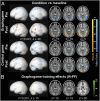Brain sensitivity to print emerges when children learn letter-speech sound correspondences
- PMID: 20395549
- PMCID: PMC2867899
- DOI: 10.1073/pnas.0904402107
Brain sensitivity to print emerges when children learn letter-speech sound correspondences
Abstract
The acquisition of reading skills is a major landmark process in a human's cognitive development. On the neural level, a new functional network develops during this time, as children typically learn to associate the well-known sounds of their spoken language with unfamiliar characters in alphabetic languages and finally access the meaning of written words, allowing for later reading. A critical component of the mature reading network located in the left occipito-temporal cortex, termed the "visual word-form system" (VWFS), exhibits print-sensitive activation in readers. When and how the sensitivity of the VWFS to print comes about remains an open question. In this study, we demonstrate the initiation of occipito-temporal cortex sensitivity to print using functional MRI (fMRI) (n = 16) and event-related potentials (ERP) (n = 32) in a controlled, longitudinal training study. Print sensitivity of fast (<250 ms) processes in posterior occipito-temporal brain regions accompanied basic associative learning of letter-speech sound correspondences in young (mean age 6.4 +/- 0.08 y) nonreading kindergarten children, as shown by concordant ERP and fMRI results. The occipito-temporal print sensitivity thus is established during the earliest phase of reading acquisition in childhood, suggesting that a crucial part of the later reading network first adopts a role in mapping print and sound.
Conflict of interest statement
The authors declare no conflict of interest.
Figures




Comment in
-
Educational neuroscience: the early years.Proc Natl Acad Sci U S A. 2010 May 4;107(18):8049-50. doi: 10.1073/pnas.1003431107. Epub 2010 Apr 26. Proc Natl Acad Sci U S A. 2010. PMID: 20421482 Free PMC article. No abstract available.
References
-
- Dehaene S, Cohen L, Sigman M, Vinckier F. The neural code for written words: A proposal. Trends Cogn Sci. 2005;9:335–341. - PubMed
-
- Cohen L, et al. The visual word form area: Spatial and temporal characterization of an initial stage of reading in normal subjects and posterior split-brain patients. Brain. 2000;123:291–307. - PubMed
-
- Brem S, et al. Evidence for developmental changes in the visual word processing network beyond adolescence. Neuroimage. 2006;29:822–837. - PubMed
-
- Vinckier F, et al. Hierarchical coding of letter strings in the ventral stream: Dissecting the inner organization of the visual word-form system. Neuron. 2007;55:143–156. - PubMed
Publication types
MeSH terms
LinkOut - more resources
Full Text Sources
Molecular Biology Databases

